White is the most classic colour when it comes to gorgeous flowers! White flowers bushes never fade in the moonlight after the sun goes down, adding a calm, enchanted touch to any environment.
An all-white flower garden can be equally as lovely as a traditional white bouquet, and white flowers only serve to accentuate the colour of the surrounding flowers. If sufficient room allows, you can also plant them in baskets or containers, in this article we have some amazing white flower bushes that we can grow in our gardens.
1. Shasta Daisy (Leucanthemum × superbum)
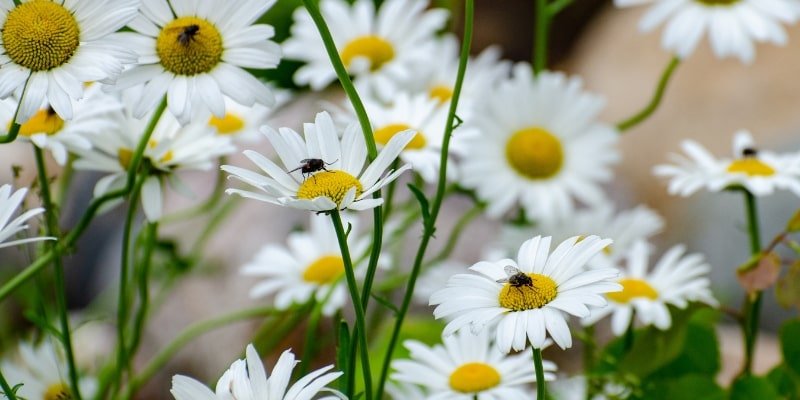
Plant type: Perennial
Plant size: Approx 2 feet
Sunlight: Full sun
Plant zone: 5-9 Zone
The daisy is said to have derived its name from the Old English term “daes eage,” which means “day’s eye,” due to the way the flower opens at the first hint of daylight.
Shasta Daisies require little maintenance once they start to grow again. These blooms can withstand a range of soil conditions and full to partial sunlight. Shasta Daisies tolerate dryness once they grow themselves and are resistant to rabbits and deer.
In your garden, these perennial plants will be spectacular for a few years. Shasta daisy plants have the potential to self-sow, which can lead to overcrowding or invasion of an area if deadheading isn’t done to prevent self-seeding.
2. Slender Deutzia (Deutzia gracilis)
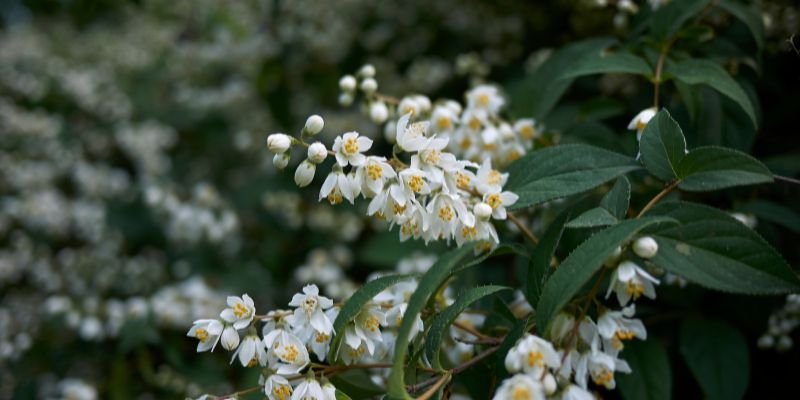
Plant type: Deciduous shrub
Plant size: 2-4 ft
Sunlight: Full to light shades
Plant zone: 5-8 Zones
The blooming shrub known as slender deutzia (Deutzia gracilis) is native to Japan. The Japanese snow blossom is another name for it. This shrub has delicate, arching stems that are covered in clusters of white blooms in late April.
Deutzia gracilis, sometimes referred to as Japanese snow flower or slender deutzia, is a plant that blooms in mid-to-late spring. Its magnificent racemes of lightly-scented white trumpet-shaped flowers are draped down the branches. Its foliage is seasonal and green.
Grow in soil that is wet and somewhat rich. Prefers the full sun. Branches that are periodically thinned will keep their arching shape.
3. Seven Son Flower (Heptacodium miconioides)
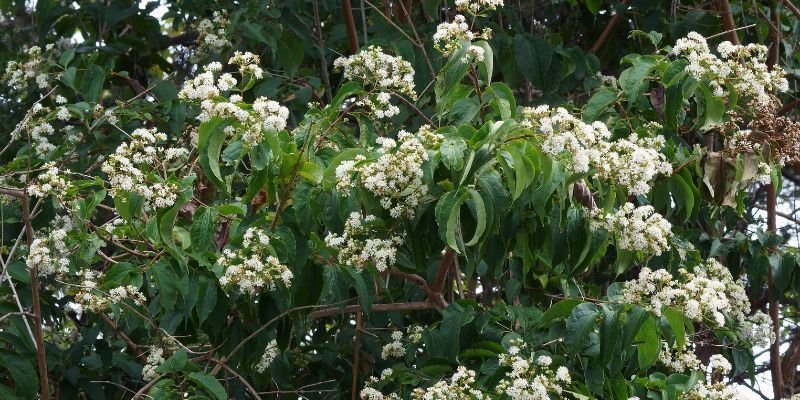
Plant type: Deciduous shrub
Plant size: 10-20 feet
Sunlight: Full to part shade
Plant zone: 5-9 Zones
The seven-son tree is an elegant, medium-sized tree with an arched top. It increases the sculpture’s attractiveness, which is emphasized by the surrounding plants or architecture
A small tree or huge shrub belonging to the Caprifoliaceae family is called a seven-son flower. It is renowned for delivering an best fragrant, nectar-rich late-season flowers that draw bees, monarch butterflies, and other pollinators. The stunning fruits and striking bark give the landscape appeal in the fall and winter.
For something different to add to your yard, this flower is a great source for vibrant Blooming bushes. Late summer to fall is when this towering plant blooms. Around drooping stems are seven blooms arranged in circular clusters. Brilliant purple fruit replaces them when they die off in the fall.
4. Flowering Dogwood (Cornus florida)
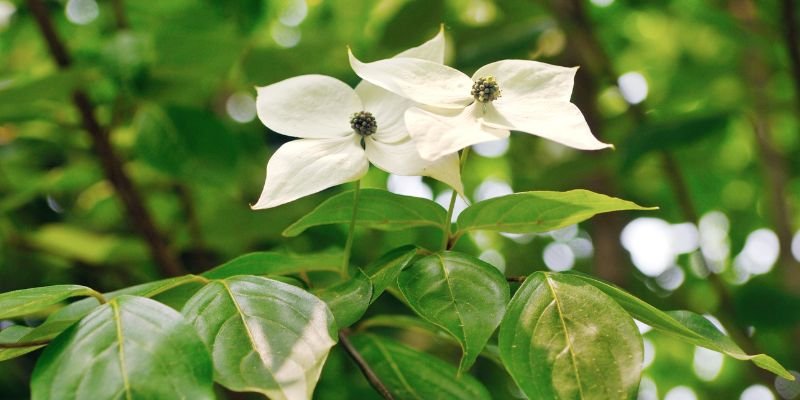
Plant type: Multi-branched, deciduous shrub
Plant size: 10-20 feet
Sunlight: Full sunlight
Plant zone: 5-9 Zones
The vibrant spring blooms of flowering dogwood are the source of its name. The fruit was described as edible but unfit for dogs during colonial times, which is where the popular name “dogwood” originated. Another theory about the common term “dogwood” is that it comes from the wood’s use for skewers or “dogs.” Cornel and Boxwood are two other common names.
Flowering dogwood is a native tree that most people are familiar with; it blossoms in early spring before leaves show.
Four huge beautiful white, blush or pink petal-like bracts surround the tiny yellowish-green blooms; they open flat to provide the appearance of a single, large white flower blushes.
5. Orchid (Orchidaceae)
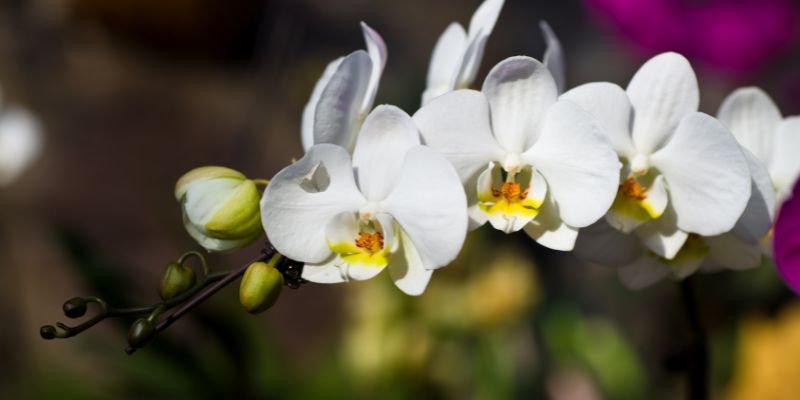
Plant type: Phalaenopsis orchid
Plant size: 3 to 4 inches
Sunlight: Indirect sunlight
Plant zone: 2-9 Zones
White orchids exude a pure beauty that makes it simpler to admire the flower’s form rather than being overwhelmed by colour. When you combine that with an alluring scent, many people believe you have the ideal orchid. In the wild, many white and light-coloured orchids release a pleasant scent at night, and moths that fly at night fertilize them.
Orchids are quite demanding to grow but very gratifying when they do well in humid, tropical areas. Indoor orchid care can be challenging, but with proper watering practices, you can enjoy long-lasting flowers.
6. Camellia (Camellia japonica)
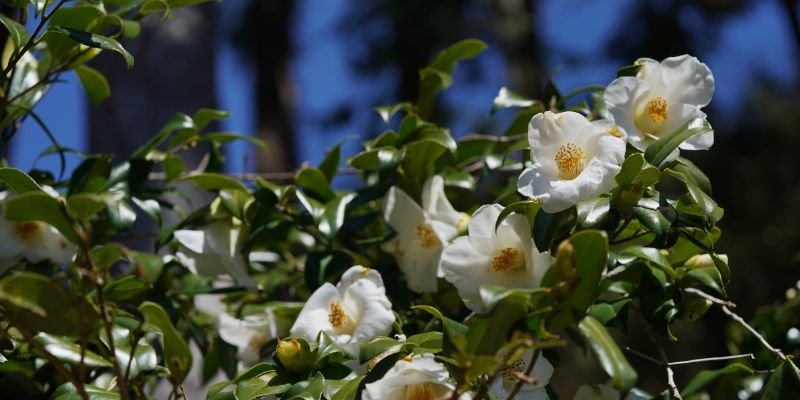
Plant type: perennial shrubs
Plant size: 8 to 10 feet
Sunlight: Partial sunlight
Plant zone: 7-9 Zones
One of the most common species in the genus is the Japanese camellia. There is a vast range of shapes, sizes, and hues among its several varieties. Grows well in well-drained, organically rich, acidic, and moist soil.
The winter-blooming camellia of the Theaceae (tea) family has a double white variety known as “White by the Gate.” Its pure white flowers blushes distinguish it from other white camellias, which often have a pink undertone to their hue.
Camellias, the queens of winter flowers, are gorgeous evergreen shrubs that are greatly appreciated for the beauty of their magnificent blooms, magnificent evergreen leaves, and compact, rounded form.
The Camellia Japonica is a class of tiny trees or striking evergreen shrubs distinguished by their beautiful blossoms and glossy coriaceous leaves. Their blooms often bloom at the dreariest period of the year, which is mid-autumn to the end of winter and far into April. Camellias need acidic, wet, but well-drained soil or compost that is high in humus.
7. Summer snapdragon (Angelonia)

Plant type: Annuals, Perennials
Plant size: 12 to 36 inches
Sunlight: Full sun for at least 6 hours
Plant zone: 9-11 Zones
This delicate perennial, also known as Angelonia ‘Angelface White’, is commonly grown as an annual in summertime. It has an abundance of huge, pure white flower blushes in spectacular spikes that bloom from late April until the first frosts.
The striking blooms have a faint grape soda scent and resemble tiny snapdragons. The medium-green, narrow, pointed leaves that cover the flexible stalks supporting them provide support. This heat-loving plant, which has many branches and a semi-upright habit, blooms continuously throughout the growing season.
It is an excellent addition to garden beds or containers where it creates a wonderful vertical accent. It is also disease resistant, heat, humidity, drought tolerant, and easy to cultivate. The blossoms also make wonderful, long-lasting cut
8. Magnolia (Magnolia spp)

Plant type: Small trees, deciduous shrubs, or evergreens
Plant size: 5-12 feet
Sunlight: Full sun partial shades
Plant zone: 4-12 Zones
Magnolias are widely available where you reside, and they are traditionally prized for their fragrant blossoms. In every kind of climate, some varieties are deciduous and evergreen. Tree and shrub species that bloom in a range of styles are available. The gorgeous Yulan Magnolia and the well-known Star Magnolia are popular white varieties.
Shrubs with white flowers and magnolias tolerate a wide range of environments well. Simply maintain the soil well-drained and slightly acidic by giving them regular irrigations. Regular pruning helps them grow.
Magnolia trees are low maintenance and resistant to a wide range of pests and illnesses. With proper growing circumstances, they can reach 100 years or more of life.
9. Mock Orange (Philadelphus coronarius)
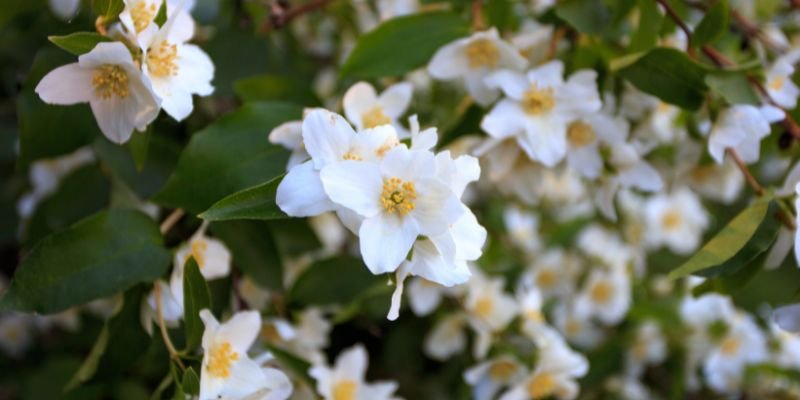
Plant type: Deciduous shrub
Plant size: 4-10 feet tall
Sunlight: Full to part sun
Plant zone: 4-9 Zones
Mock orange shrubs should be on your gardening wish list if you would enjoy the aroma of orange flowers filling your garden. With their delicious white blossoms luring butterflies and bees to the garden, these fragrant deciduous shrubs are at their finest in the spring and early summer Plants. Their unique aroma permeates the house, and the blooms make great cut flowers.
The shrub is magnificent when it blooms, but it looks ordinary the rest of the year. That being said, other flowers get a visually pleasing backdrop from their green foliage before winter starts.
10. Water hyssop (Bacopa monniera)
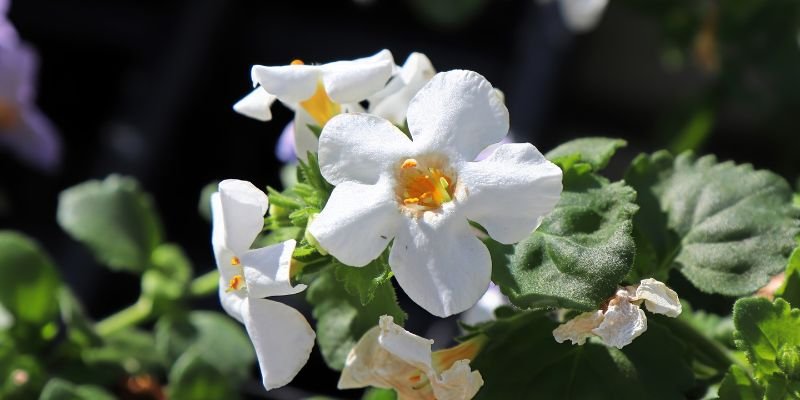
Plant type: Annual or perennial
Plant size: 3-12 inches high
Sunlight: Full to partial light shades
Plant zone: 8-11 Zones
Bacopa monnieri is an aquatic herb that has been used both medicinally and as a decorative flower in ponds and aquariums.
The creeping, mat-forming perennial water hyssop (Bacopa monnieri) is indigenous to warm wetland habitats over most of the world. Tiny succulent leaves grow on up to 4-foot-tall stems, and tiny white bell-shaped flower bloom from spring to fall (or, in warmer locations, all year round).
Water hyssop grows best in bogs, water gardens, hanging baskets, and spilling-over pot edges. As a ground cover, it will also spread quickly over damp soil or shallow water.
11. Petunia (Petunia × atkinsiana)
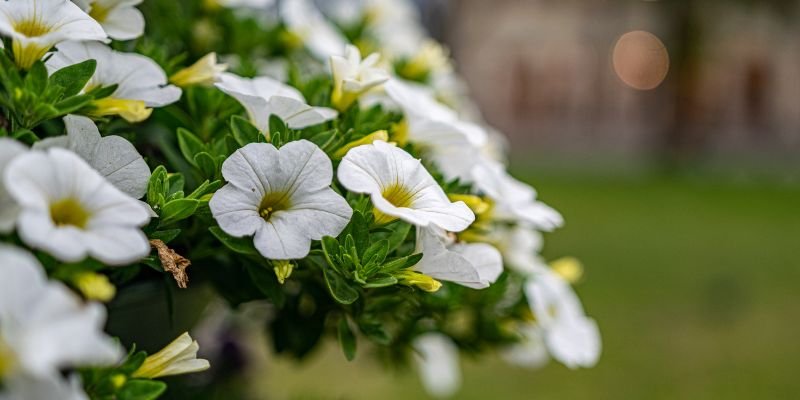
Plant type: Annual
Plant size: 10’ height 6-8’ width
Sunlight: At least 5-6 direct sunlight
Plant zone: 9-10 Zones
What a stunning display of sparkling white petunias in a summer garden! Easy to grow from flowering seed, this Grandiflora white combines the best of both worlds as it has the superb garden display of the small-flowered multifloras and grandiflora’s large-looking blooms.
One of the most well-liked garden annuals is the petunia. They work well for hanging baskets, beds, borders, and pots. Heat tolerance, simple maintenance, and spring-to-fall blooming are some of their best qualities. Petunias also attract beneficial pollinators, such as hummingbirds, butterflies, and bees..
12. Firedance Dogwood(Cornus sericea ‘Bailadeline’)

Plant type: Deciduous
Plant size: 3-4 foot tall
Sunlight: Full to partial shade
Plant zone: 2-7 Zones
Firedance Compared to the species, dogwood is more compact and has a more regular habit. Pretty white berries that attract birds follow the white flower blushes that bloom in the spring.
Adding multi-season appeal, the foliage turns a lovely reddish-purple in the fall and is followed by red stems in the winter. It works well on slopes to hold soil in place, is tolerant to damp environments, and is appropriate for rain gardens.
13. Virginia Sweetspire (Itea virginica)
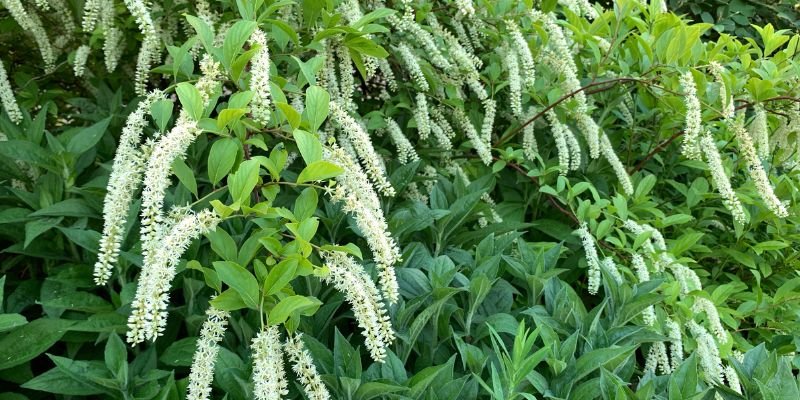
Plant type: Semi-evergreen to deciduous shrubs
Plant size: 4-6 feet high
Sunlight: full and partial sun
Plant zone: 5-9 zones
A shrub that gradually arches over its thin, upright branches; typically wider than tall. May through June bring clusters of very fragrant, drooping creamy white blooms. Fall brings a show of red and scarlet leaves that last for weeks.
The leaves are originally dark green. Hummingbirds, bees, and butterflies are drawn to the white flowering bushes of Virginia sweetspire, which have a faint fragrance.
14. Serviceberry (Amelanchier)
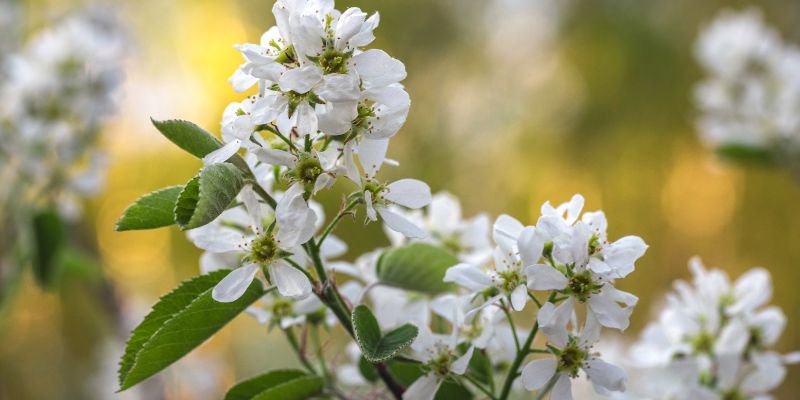
Plant type: Deciduous shrub or little tree
Plant size: Depending on its type, 4–40 feet
Sunlight: needs at least 6 hours of full sunlight
Plant zone: 4-9 Zones
Serviceberry is another name for June berry of Sugar Plum. roughly twenty species produce shrubs and tree variant. There is some variation in the size and shape of the flowers among them. All of them, however, have white flower bushed and small, elliptical leaves that turn a bright orange in the fall.
The tasty purple fruit, smooth grey bark, yellow to red fall foliage, and white spring blossoms of the serviceberry all add year-round attractiveness.
15. Rose of Sharon(Hibiscus syriacus)
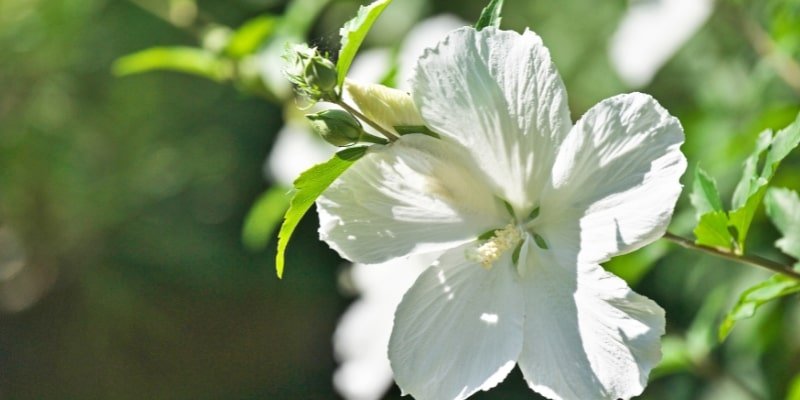
Plant type: Deciduous shrub or tree
Plant size: 8 to 12 feet tall
Sunlight: Indirect sun
Plant zone: 5-8 Zones
The rose of Sharon, or Hibiscus syriacus, is a member of the mallow family and a blooming shrub or small tree native to Asia. It is well-known for its spectacular flowers, which come in a range of hues from white to bicolour to red, pink, lavender, and blue, and bloom from midsummer to fall.
Rose of Sharon White can be cultivated with ease in full sun to partial shade on average, well-drained, medium-moisture soils. In full sun, flowers blushes at their best. It prefers moist, organically rich soils, yet it may survive poor soils and light drought. Highly resistant to the summer’s heat and humidity.

